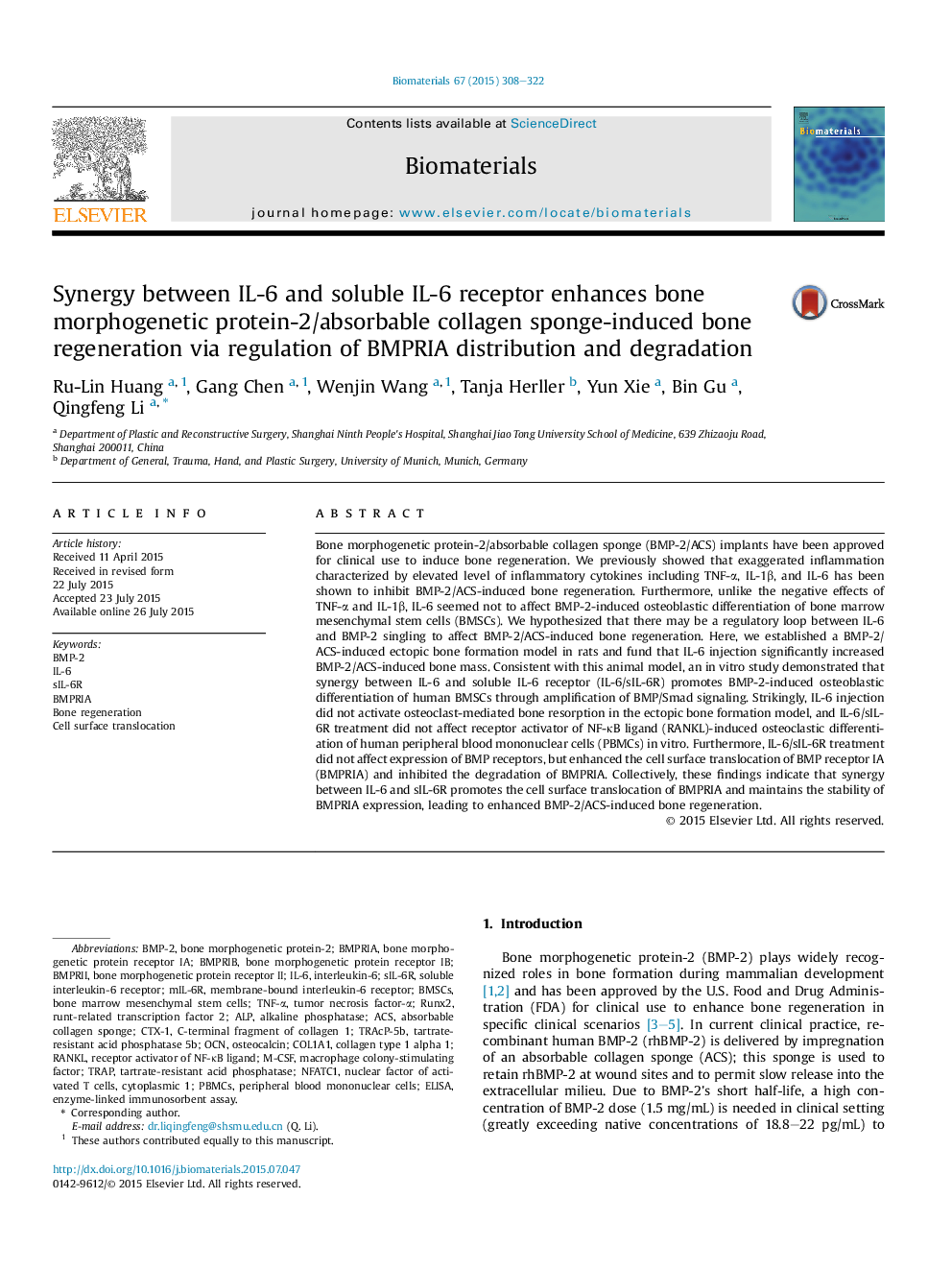| Article ID | Journal | Published Year | Pages | File Type |
|---|---|---|---|---|
| 6485469 | Biomaterials | 2015 | 15 Pages |
Abstract
Bone morphogenetic protein-2/absorbable collagen sponge (BMP-2/ACS) implants have been approved for clinical use to induce bone regeneration. We previously showed that exaggerated inflammation characterized by elevated level of inflammatory cytokines including TNF-α, IL-1β, and IL-6 has been shown to inhibit BMP-2/ACS-induced bone regeneration. Furthermore, unlike the negative effects of TNF-α and IL-1β, IL-6 seemed not to affect BMP-2-induced osteoblastic differentiation of bone marrow mesenchymal stem cells (BMSCs). We hypothesized that there may be a regulatory loop between IL-6 and BMP-2 singling to affect BMP-2/ACS-induced bone regeneration. Here, we established a BMP-2/ACS-induced ectopic bone formation model in rats and fund that IL-6 injection significantly increased BMP-2/ACS-induced bone mass. Consistent with this animal model, an in vitro study demonstrated that synergy between IL-6 and soluble IL-6 receptor (IL-6/sIL-6R) promotes BMP-2-induced osteoblastic differentiation of human BMSCs through amplification of BMP/Smad signaling. Strikingly, IL-6 injection did not activate osteoclast-mediated bone resorption in the ectopic bone formation model, and IL-6/sIL-6R treatment did not affect receptor activator of NF-κB ligand (RANKL)-induced osteoclastic differentiation of human peripheral blood mononuclear cells (PBMCs) in vitro. Furthermore, IL-6/sIL-6R treatment did not affect expression of BMP receptors, but enhanced the cell surface translocation of BMP receptor IA (BMPRIA) and inhibited the degradation of BMPRIA. Collectively, these findings indicate that synergy between IL-6 and sIL-6R promotes the cell surface translocation of BMPRIA and maintains the stability of BMPRIA expression, leading to enhanced BMP-2/ACS-induced bone regeneration.
Keywords
BMPRIInuclear factor of activated T cells, cytoplasmic 1mIL-6RCTx-1TRACP-5babsorbable collagen spongeNFATc1COL1A1M-CSFOCNBMPRIBBMPRIAPBMCsTRAPRANKLIL-6BMP-2RUNX2ACSBMSCssIL-6RALPAlkaline phosphataseOsteocalcinTartrate-resistant acid phosphatase 5btartrate-resistant acid phosphataseinterleukin-6Bone regenerationEnzyme-linked immunosorbent assayELISAtumor necrosis factor-αbone marrow mesenchymal stem cellsperipheral blood mononuclear cellsRunt-related transcription factor 2TNF-αmacrophage colony-stimulating factorBone morphogenetic protein-2collagen type 1 alpha 1Soluble interleukin-6 receptorreceptor activator of NF-κB ligand
Related Topics
Physical Sciences and Engineering
Chemical Engineering
Bioengineering
Authors
Ru-Lin Huang, Gang Chen, Wenjin Wang, Tanja Herller, Yun Xie, Bin Gu, Qingfeng Li,
